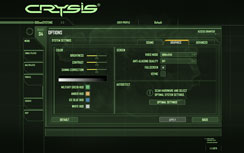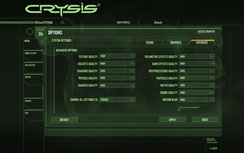
Crysis
Publisher: Electronic ArtsWhat can we say about this game that hasn’t been said already? Crysis was the most anticipated game on the PC last year and was released on November 16th 2007.
Crysis is seen by many as the poster boy for DirectX 10 and it will make your system cry, quite literally – it’s a monster! It doesn’t come as much of a surprise then, that the graphics are something special – they’re above and beyond anything we’ve ever seen in a PC game.
We tested the game using the 64-bit executable under DirectX 10 with the 1.21 patch applied. Rather than use our custom timedemo, we used a manual run through in order to gauge exactly how our system performs in this title. We did this on the Harbor map and we found that around 25-30 frames per second was sufficient enough to obtain a playable frame rate through the rest of the game. It's a little different to other games in that the low frame rates still appear to be quite smooth.
For our testing, we found the highest-playable settings at both 1,280 x 1,024 and 1,680 x 1,050 with the machine in both its stock and overclocked states. Anisotropic filtering (where applicable) was controlled from the driver control panel, while all other settings were controlled from inside the game.
| Crysis | |||||
| Highest Playable Settings - 1,280 x 1,024 | |||||
| System Settings | Avg | Min | AA | AF | Details |
| CPU: 1,800MHz (9.0 x 200) GPU: 700/1,750/2,000MHz Mem: DDR2-667 5-5-5-15-2T | 27.5 | 11 | 0x | 0x | High Textures/Sound All Other Settings: Medium No Motion Blur |
| CPU: 2,907MHz (9.0 x 323) GPU: 774/1,896/2,084MHz Mem: DDR2-800 5-5-5-15-2T | 29.1 | 9 | 0x | 0x | High Textures/Shaders/Water/Sound All Other Settings: Medium No Motion Blur |
With our system running at stock speeds, we had a fairly respectable gaming experience at 1,280 x 1,024. We were able to set texture quality to high, while every other graphical setting was turned to medium quality - this was more than acceptable for a machine of this class.
When we re-tested the game with our system heavily overclocked, we unsurprisingly found some decent gameplay improvements. Not only could we set shaders to high, but we could also set water to high as well - combined, the two had a telling effect on the gaming experience. The higher shaders setting enabled more realistic lighting, while waves and splashes were much more realistic with water quality set to high.
The frame rates also increased too and, after testing the game again with the CPU at stock and the GPU overclocked, it quickly became apparent that the frame rate increase was as a result of the CPU clock. Our frame rates dropped down to around 25-26 frames per second, although we were still able to keep the higher quality settings turned on.
| Crysis | |||||
| Highest Playable Settings - 1,680 x 1,050 | |||||
| System Settings | Avg | Min | AA | AF | Details |
| CPU: 1,800MHz (9.0 x 200) GPU: 700/1,750/2,000MHz Mem: DDR2-667 5-5-5-15-2T | 26.4 | 14 | 0x | 0x | Medium Texture/Shaders/Water/Sound/ Object/Post Processing/Volumetric All Other Settings: Low No Motion Blur |
| CPU: 2,907MHz (9.0 x 323) GPU: 774/1,896/2,084MHz Mem: DDR2-800 5-5-5-15-2T | 28.1 | 10 | 0x | 0x | High Textures/Sound All Other Settings: Medium No Motion Blur |
When we moved to 1,680 x 1,050, we had a lot of fun tweaking the game settings to get it playable on our stock-clocked system, but after playing around with each and every setting, we found our what was causing the most problems for us. With the CPU clocked at just 1,800MHz, we found that particles, physics and game effects in particular caused some performance-related problems when they were set to medium and we had to set them to low quality to maintain acceptable frame rates.
We tried again with the CPU overclocked to 2,907MHz and, although the frame rates weren't quite as high as it was with the GPU overclocked as well, we were able to get a much better gaming experience with particles, physics and game effects set to medium. However, in order to maintain playable frame rates, we had to leave shadows set to low with a CPU overclock and no GPU overclock.
Once both the GPU and CPU were overclocked, we were able to enjoy Crysis at 1,680 x 1,050 with all in-game settings turned to medium. If you ask me, that's pretty impressive for a system that cost us so little to put together!

MSI MPG Velox 100R Chassis Review
October 14 2021 | 15:04










Want to comment? Please log in.